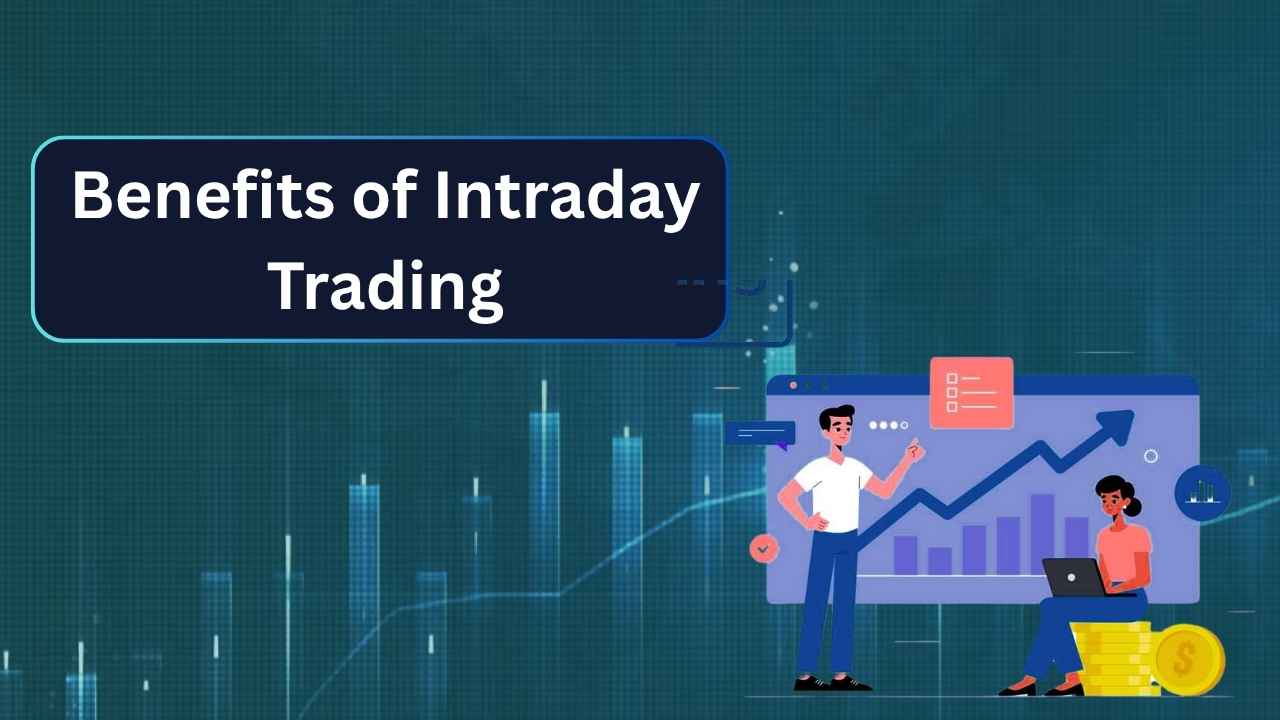Benefits of Intraday Trading- Intraday trading, commonly referred to as day trading, represents one of the most dynamic approaches to stock market participation. Rather than holding securities for extended periods, intraday traders execute buy and sell orders within the same trading session to capitalize on short-term price movements.
When executed with discipline, comprehensive market knowledge, and appropriate tools, intraday trading can deliver substantial benefits—ranging from rapid profit generation to enhanced liquidity and optimized capital efficiency. This comprehensive guide examines the primary advantages of intraday trading, its operational framework, suitable trader profiles, and strategies for maximizing returns.
What is Intraday Trading?
Intraday trading involves the purchase and sale of securities within a single trading day, with all positions closed before market closure. Traders leverage short-term price fluctuations in stocks, indices, or derivatives to generate returns.
Consider this example: An investor purchases 100 shares of TCS at ₹3,600 during morning trading hours. By afternoon, when the price appreciates to ₹3,650, the shares are sold, resulting in a ₹5,000 profit—all executed within one trading session.
Unlike long-term investors who depend on fundamental company growth or dividend income, intraday traders profit from market volatility. They capitalize on continuous price movements that occur throughout each trading day.
Operational Framework of Intraday Trading
Intraday trading is predicated on technical analysis, precise timing, and a comprehensive understanding of market psychology. Traders utilise real-time market data, technical charts, and analytical indicators to identify short-term opportunities. The process encompasses these key steps:
- Security selection focusing on high-liquidity, high-volatility stocks (such as Reliance, TCS, Infosys, or HDFC Bank)
- Target establishment including entry price, target price, and stop-loss parameters before trade execution
- Trade execution based on price action analysis or technical indicators
- Position closure before market close to eliminate overnight exposure
This fast-paced, data-driven methodology requires strategic planning and rapid decision-making capabilities, which explains its appeal among active market participants seeking immediate opportunities.
Top 10 Benefits of Intraday Trading
Let’s dive into the key benefits that make intraday trading one of the most popular trading styles in India.
1. Rapid Profit Generation
Traditional investment strategies require extended timeframes—often months or years—to realize returns. Intraday trading enables profit realization within hours or even minutes. Traders can capitalize on modest price movements triggered by market volatility, news events, or corporate announcements.
Consider this scenario: A stock appreciating from ₹200 to ₹205 represents a modest 2.5% gain. However, for an intraday trader managing 5,000 shares, this translates to a profit of ₹25,000 in a single day. Prioritising high-volume stocks is advisable, as they typically demonstrate greater price momentum and superior trading opportunities.
2. Elimination of Overnight Risk
A significant advantage lies in the absence of overnight position holding. Capital remains unexposed to global market fluctuations, after-hours developments, corporate announcements, or geopolitical events that occur outside trading hours.
By closing all positions before market closure, traders avoid overnight price gaps or unexpected losses. This ensures risk exposure remains within predetermined parameters and eliminates uncertainty associated with overnight market developments.
3. Leverage and Margin Advantages
Indian brokers provide margin trading facilities for intraday transactions, enabling traders to control positions valued at 5x to 10x their actual capital investment. With ₹50,000 in capital, traders might access positions worth ₹2,50,000 or more.
While this amplifies profit potential, it correspondingly increases risk exposure. Prudent risk management becomes imperative when utilizing leverage facilities.
| Broker | Approximate Intraday Leverage (2025) |
|---|---|
| Zerodha | Up to 5x |
| Upstox | Up to 7x |
| Angel One | Up to 10x |
| ICICI Direct | Up to 6x |
| Fyers | Up to 5x |
Leverage regulations are governed by SEBI, with margins varying by security type and market segment.
4. Superior Liquidity and Operational Flexibility
Intraday trading concentrates on liquid securities—those with substantial trading volumes. High liquidity ensures rapid trade execution without significantly impacting market prices. This proves particularly valuable when executing multiple transactions within a single session.
The flexibility to transition between sectors, industries, and securities provides daily diversification opportunities. Traders maintain complete position flexibility and can adapt swiftly to evolving market conditions.
5. Reduced Transaction Costs
The absence of overnight position holding results in lower brokerage fees and transaction costs compared to long-term investment strategies. Most brokers offer discounted intraday brokerage structures—some as competitive as ₹20 per trade, irrespective of transaction size.
Over extended periods, these cost savings accumulate significantly, enhancing overall profitability. Every rupee conserved on transaction expenses contributes directly to net returns.
6. Bidirectional Profit Potential
Unlike traditional investors who generate returns exclusively from price appreciation, intraday traders can profit during market declines through short-selling strategies. This involves selling securities initially and subsequently repurchasing them at lower prices.
The mechanism operates as follows: If market analysis indicates Infosys will decline from ₹1,600 to ₹1,570, a trader can short-sell 100 shares. When the price reaches ₹1,570, repurchasing the shares yields ₹3,000 profit. This bidirectional earning capability represents a fundamental advantage of intraday trading.
7. Immediate Performance Feedback
Intraday trading delivers instantaneous feedback on trading strategies. Extended waiting periods for performance evaluation are unnecessary. Each transaction provides valuable insights regarding market psychology, timing precision, risk management effectiveness, and entry-exit execution.
This continuous feedback mechanism accelerates skill development. Traders can refine their methodologies daily based on empirical results, facilitating more rapid proficiency development than traditional investment approaches would permit.
8. Daily Income Generation Potential
Numerous full-time traders establish intraday trading as their primary income source. Through consistent practice, disciplined execution, and sophisticated risk management, regular daily profit generation becomes attainable.
Part-time traders and working professionals can participate by dedicating 1-2 hours daily, utilizing automated alerts or predetermined trading configurations. This flexibility accommodates diverse lifestyle requirements.
9. Optimized Capital Utilization
Capital maintains complete liquidity daily, as all positions close before market end. Unlike long-term investment strategies requiring extended capital commitment, funds become available immediately for new trading opportunities.
This enables capital recycling multiple times monthly, amplifying potential returns over time. Capital deployment becomes significantly more efficient and frequent.
10. Access to Advanced Trading Technology
Contemporary trading platforms, including Zerodha Kite, Upstox Pro, and TradingView, provide sophisticated tools, real-time data feeds, and advanced charting capabilities. Traders access real-time technical indicators, automated alert systems, candlestick pattern recognition, market heatmaps, and comprehensive screening tools.
These technological resources render intraday trading more scientific, data-driven, and efficient than ever before. Resources previously available exclusively to institutional participants are now accessible to individual traders.
Comparative Analysis: Intraday Trading vs Long-Term Investing
| Parameter | Intraday Trading | Long-Term Investing |
|---|---|---|
| Holding Period | Same day | Months to years |
| Risk Level | High (short-term volatility) | Moderate (long-term stability) |
| Capital Requirements | Low (with margin facilities) | Moderate to high |
| Return Potential | High (daily profits possible) | Stable and compounding |
| Market Focus | Short-term technical trends | Company fundamentals |
| Liquidity | Very high | Low to medium |
Who Should Try Intraday Trading?
Intraday trading is not universally appropriate; however, it suits active traders with sufficient time for market monitoring, technical analysts proficient in chart interpretation, individuals comfortable with short-term risk exposure, and professionals seeking daily income opportunities.
If you possess strong analytical capabilities, rapid decision-making skills, and thrive in dynamic environments, intraday trading may represent a suitable pursuit. However, success requires sustained dedication and continuous learning commitment.
Strategies for Maximizing Trading Success
Implementing these practical guidelines can substantially enhance intraday trading outcomes:
- Consistently utilize stop-loss orders to protect capital
- Avoid overtrading by prioritizing quality trading setups over quantity
- Maintain emotional discipline and adhere to predetermined strategies
- Employ reliable charting software such as TradingView and ChartIQ for analytical precision
- Stay informed regarding news developments, events, and announcements with market-moving potential
Intraday trading success depends equally on psychological discipline and technical proficiency. Mental fortitude often determines outcomes more significantly than technical knowledge alone.
Conclusion
Intraday trading offers substantial opportunities for rapid profit generation, enhanced liquidity, and continuous skill development. It enables traders to capitalize on daily market fluctuations, efficiently utilize leverage, and profit from both bullish and bearish market conditions.
However, like all trading methodologies, it demands rigorous discipline, comprehensive risk control, and persistent practice. Success requires sustained effort, learning from setbacks, and continuous strategy refinement.
When approached with appropriate mindset and well-developed strategies, intraday trading can deliver both financial returns and intellectual satisfaction. The combination of analytical challenge, strategic thinking, and potential financial rewards appeals to many market participants.
For those prepared to develop the requisite skills and maintain disciplined execution, the opportunities within intraday trading merit serious consideration. Begin with modest capital allocation, prioritise continuous learning, and allow empirical results to guide your development.
Learn More:
- Difference in Expense Ratio Between Direct and Regular Mutual Funds
- Best Small-Cap Index Funds
- 10 Debt Mutual Funds That Outperformed in the Last 1 Year with 10% to 24% Returns in 2025
- Best Tyre Stocks in India
- Best Healthcare Stocks in India
Risk Disclaimer
Important Notice: Intraday trading involves substantial risk and may not be suitable for all investors. The high degree of leverage available can work against you as well as for you. Past performance is not indicative of future results. Before deciding to trade, you should carefully consider your investment objectives, level of experience, and risk tolerance.
The possibility exists that you could sustain losses in excess of your initial investment. Therefore, you should not invest money that you cannot afford to lose. You should be aware of all the risks associated with intraday trading and seek advice from an independent financial advisor if you have any doubts.
All trading decisions are the sole responsibility of the individual trader. The information provided in this guide is for educational purposes only and should not be construed as investment advice. Markets can be volatile, and prices can move rapidly against your positions.
Intraday Trading: FAQs
Is intraday trading profitable?
Intraday trading can generate substantial profits when executed with proper discipline, well-developed strategy, and comprehensive risk management protocols. However, profitability correlates directly with skill level, market experience, and emotional control capabilities.
What is the optimal time for intraday trading in India?
The initial two hours following market opening (9:15 AM – 11:15 AM) and the final hour (2:30 PM – 3:30 PM) typically offer optimal volatility and trading opportunities due to increased market participation and liquidity.
What capital requirements exist for initiating intraday trading?
Initial capital requirements can be modest, with feasibility beginning at ₹5,000–₹10,000 due to margin trading facilities offered by brokers. However, larger capital allocations provide enhanced flexibility and superior risk management capabilities.
Can novice traders engage in intraday trading?
Beginners can participate in intraday trading; however, they should commence with minimal capital, develop technical analysis proficiency, and practice extensively using virtual trading accounts before deploying real capital. Comprehensive education and preparation are essential for sustainable success.
What risk levels are associated with intraday trading?
Intraday trading involves elevated short-term risk exposure. However, through disciplined stop-loss implementation and comprehensive planning, risks can be managed and maintained within acceptable parameters. Risk management should be the primary focus for all traders.













